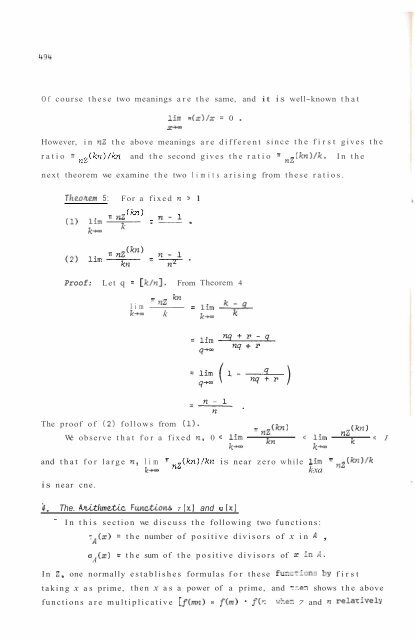You also want an ePaper? Increase the reach of your titles
YUMPU automatically turns print PDFs into web optimized ePapers that Google loves.
Of course these two meanings are the same, and it is well-known thatlim v(x)/x = 0 ._C-È-cHowever, in nZ the above meanings are different since the first gives theratio IT nz(kn)/kn and the second gives the ratio n(kn)/k. In thenZnext theorem we examine the two limits arising from these ratios.The.on.ew 5: For a fixed n > 1TT nZ -(1) lim- --kk-Proof: Let q = [k/n]. Fromnz knl i m - =k-m kTheorem 4l i m +k-xaThe proof of (2) follows from (1).T ^(fen)nz(kn)We observe that for a fixed n, 0 < iim kn < l i m < 1k-xa k*and that for large n, lim vnz(kn)/kn is near zero while Iim n (kiz)/kn2k-r-k-xais near cne.2. The. AluJLIma^cc Fundore4 T [x) and o 1x1" In this section we discuss the following two functions:~ ( x = ) the number of positive divisors of x in A ,o (x) = the sum of the positive divisors of x In A.AIn 2, one normally establishes formulas for these fu~?l,:.n- by firsttaking x as prime, then x as a power of a prime, and :.-.enshows the abovefunctions are multiplicative [f(mn) = f(m) f(1: .-¥he 7 and n relarivelyprime] so that one can rely on FTA2 to obtain the formulas for composites.Since factorization is not unique in nZ, this process will not work.the following approach we see that these functions are "nearly" multipli-cative in nZ.We first establish the formulas for powers of n and thenfor composites. Clearly, if x is prime in nZ, then T (x) = 0 = a (x).nZnZWe saw before that if x is composite .In EZ, we can write x = kn m wherem  2 and n 1 k.m-1mLemma 2: If x = n m , then ~ ~ ) = ~ m - 1 ( and n o nZ (nm) = nr.r=1Proof: The positive divisors of nm in nZ are n, n< n 3 ,m-1' - ', nand the formulas follow easily.Tke.okem 6 : If x = kn m where m  2 and n ) k, thenm~ ( k ) n = (m - 1) ~ ( k = ) T (nm) ~.(k)nZProof: Each divisor of k multiplied by n is a divisor of x. Eachdivisor of k multiplied by n2 is a divisor of x. Inductively, each divisorof k multiplied by n m- 1 is a divisor of x. Since k does nothave n as a factor neither do the divisors of k and so the divisorsnamed above are all distinct.visors of x. Since each row contributes TMoreover, these are all the positive di-z(k) divisors of x and sincethere are m - 1 rows, there are therefore (m - 1) ~,,(k) divisors of xLiin nZ. To find aZ(knm) we merely add up the divisors in each row. Thesum cf the jth row is n3dle equality.oZ(k). Summing the m - 1 rows gives the mid-Lemma 2 gives the last equalities in the two formulas.In a future paper we shall discuss in nZ the notions of greatestcommon divisor, relative primeness, and Euler's function ifi(x).REFERENCES1. Andrews, '3. E., Number Theory, W. B. Saunders Company, Philadelphia,Pennsylvania, 1971.2. Barnett, I. A., Elements cf Number Theory, Prindle, Weber, andSchmidt, Inc., Bosten, Massachusetts, 1969.3. Hardy, G. H. and Wright, E. M., An Introduction to the Theory ofNumbers, Oxford 'Jniversity Press, 4th ed., New York, 1960,4. Niven, I. and Zuckerman, H. S., An Introduction to the Theory ofNumbers, 2nd ed., John Wiley and Sons, Inc. , New York, 1966.In
















